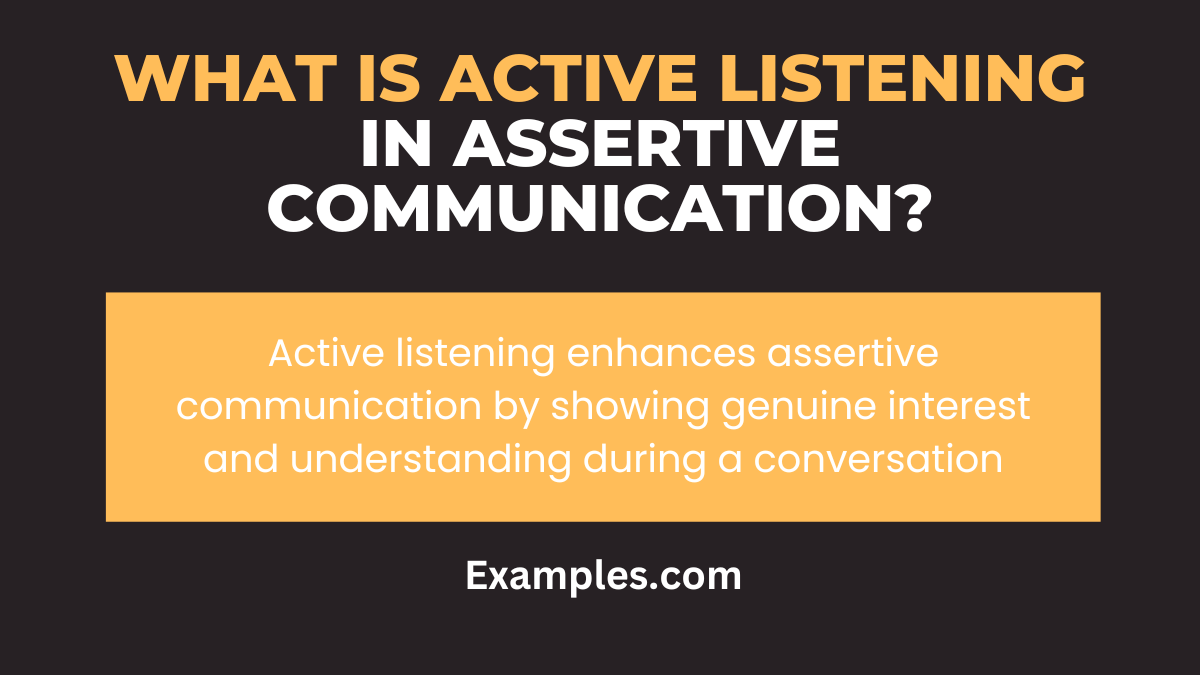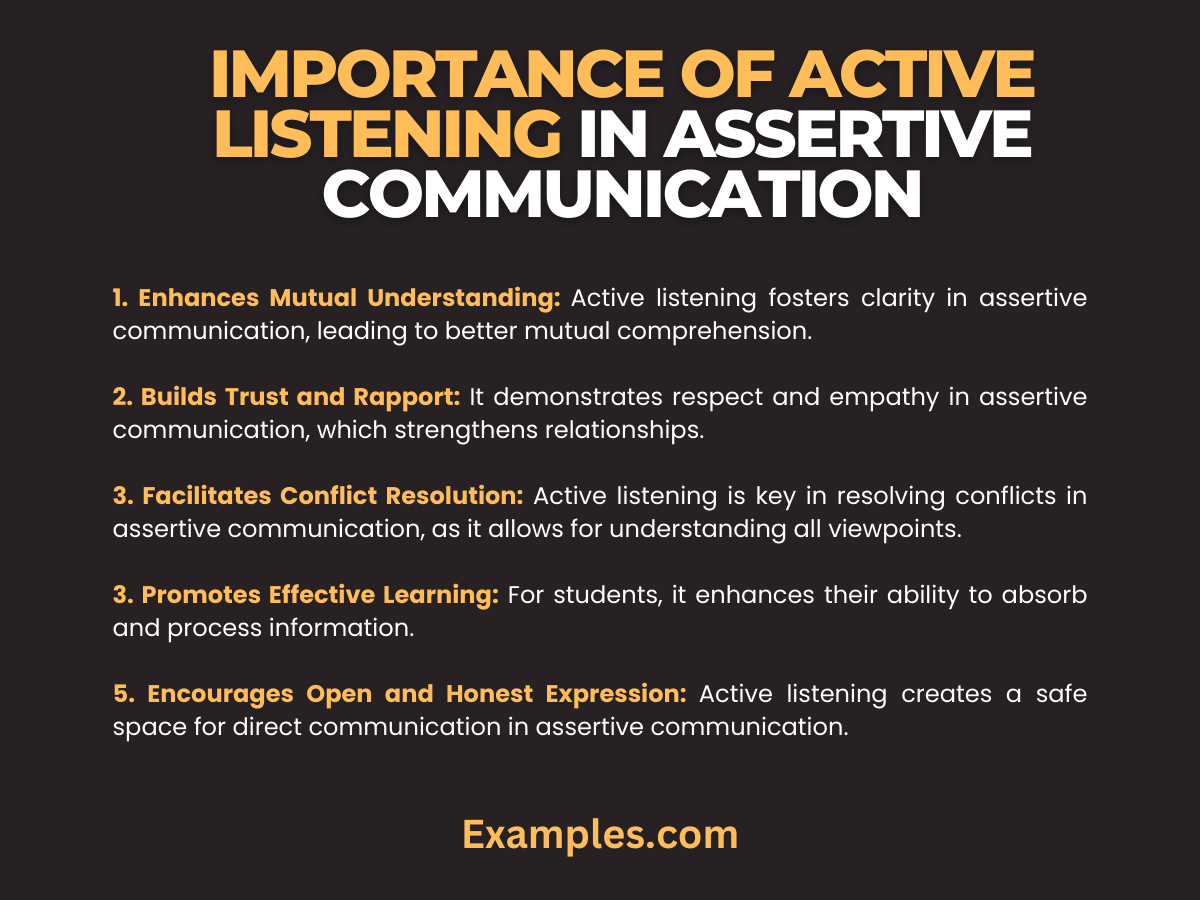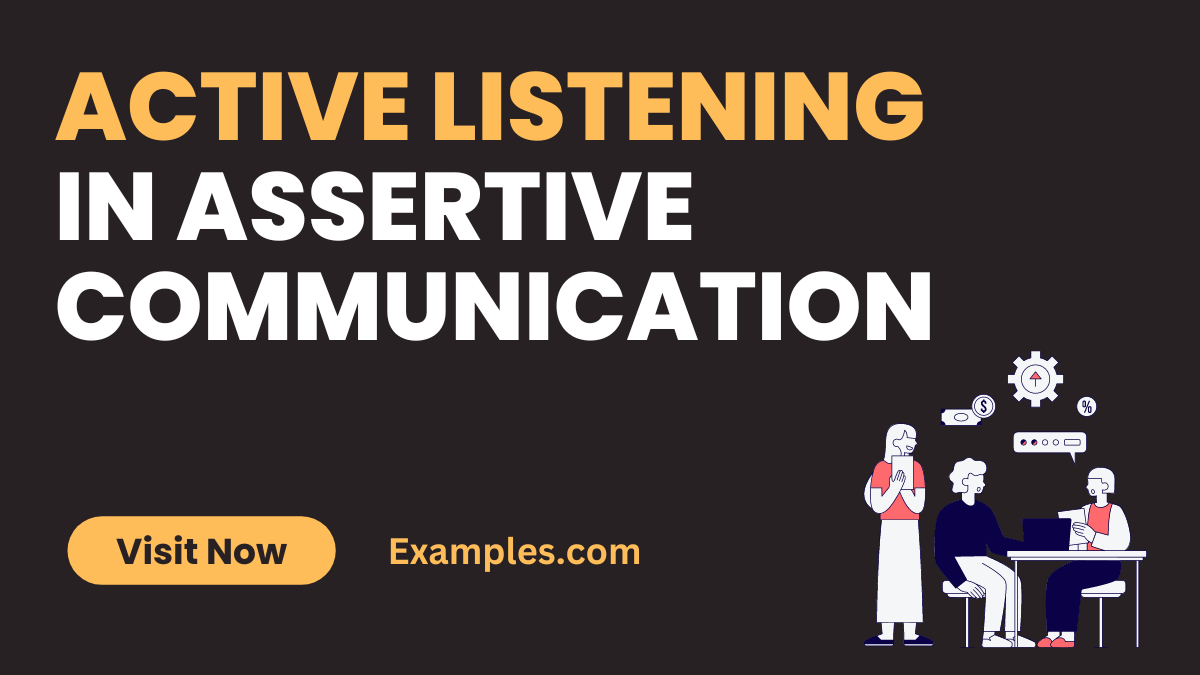29+ Active Listening in Assertive Communication Examples
Active listening in assertive communication is a vital skill for effective interpersonal interactions. It involves attentively listening to others, understanding their perspective, and responding respectfully. This approach enhances assertive communication, ensuring clear, respectful, and empathetic exchanges. This guide delves into the intricacies of active listening within the framework of assertive communication, a combination pivotal for personal and professional success.
What is Active Listening in Assertive Communication?

Active listening in assertive communication is a dynamic process that combines attentive listening with assertive expression. It’s not just about hearing words but understanding the speaker’s intent, emotions, and perspective. This skill requires full concentration, empathy, and non-judgmental engagement with the speaker. By practicing active listening in assertive communication, individuals can effectively convey respect and understanding, leading to more constructive and satisfying interactions.
30 Examples of Active Listening in Assertive Communication?
Active listening is a cornerstone of assertive communication, vital for understanding and responding effectively in conversations. It involves fully concentrating, understanding, responding, and remembering what is being said. Active listening in assertive communication enables clear expression and fosters mutual respect, making it an essential skill in personal and professional interactions.
- “I hear you’re concerned about the deadline. How can we address this together?” This response shows understanding and willingness to collaborate.
- “It sounds like you’re frustrated with the team’s progress. Let’s find a solution.” Acknowledging the speaker’s emotions and suggesting a joint resolution.
- “I understand you need more resources. What exactly would help you?” Clarifying needs to provide specific support.
- “So, if I’m hearing you correctly, your main concern is the budget?” Paraphrasing to ensure correct understanding of the issue.
- “I appreciate your honesty about the challenges you’re facing. Let’s discuss potential solutions.” Valuing the speaker’s openness and moving towards problem-solving.
- “Can you tell me more about your experience with this project?” Encouraging elaboration for deeper understanding.
- “I recognize that this is important to you. What’s your ideal outcome?” Acknowledging the speaker’s priorities and exploring desired results.
- “It seems like you have some great ideas. Could you elaborate on them?” Expressing interest in the speaker’s suggestions and encouraging further sharing.
- “Let’s break down the issues you’ve raised and address them one by one.” Organizing thoughts to tackle problems systematically.
- “I can see how that situation would be frustrating. How do you think we should proceed?” Showing empathy and seeking the speaker’s perspective on solutions.
- “I’m listening intently. Please continue.” Reinforcing the importance of the speaker’s message and encouraging continued dialogue.
- “Your point about workload distribution is valid. How can we make adjustments?” Validating concerns and discussing practical changes.
- “I want to make sure I understand. You’re saying that communication needs improvement, right?” Seeking clarification to ensure accurate comprehension.
- “It’s helpful to hear your viewpoint on this matter. What are your thoughts on potential improvements?” Recognizing the speaker’s contribution and asking for suggestions.
- “Thank you for sharing your concerns. Let’s explore how we can address these together.” Expressing gratitude for the input and suggesting a collaborative approach.
- “I sense you’re worried about the project’s direction. What changes would you suggest?” Identifying emotions and prompting for specific recommendations.
- “Your experience with this client is valuable to us. What approach do you recommend?” Acknowledging expertise and seeking advice.
- “Let me repeat what I’ve heard to make sure I’ve got it right.” Summarizing to confirm understanding.
- “It’s clear this issue matters to you. How can I support you in resolving it?” Acknowledging the significance of the issue and offering assistance.
- “I notice you seem hesitant about the proposal. Can you share your concerns?” Observing non-verbal cues and inviting open communication.
- “Your feedback is important. Could you provide more details?” Encouraging detailed input for better understanding.
- “I understand the deadline is tight. What resources do you need to meet it?” Recognizing constraints and discussing necessary support.
- “It sounds like there are several factors at play here. Could you prioritize them for me?” Asking for clarification on the most critical aspects.
- “Your perspective on this issue is unique. How did you arrive at this conclusion?” Showing interest in the speaker’s reasoning process.
- “I’m focused on understanding your viewpoint. Please explain further.” Communicating commitment to fully grasp the speaker’s perspective.
- “You’ve raised some interesting points. How do these fit into our overall goal?” Connecting individual ideas to the broader objective.
- “Your concerns are valid. What steps can we take to mitigate these issues?” Validating concerns and seeking actionable steps.
- “I’m intrigued by your approach. Can you walk me through your thought process?” Expressing genuine interest and requesting detailed explanation.
- “Let’s ensure we’re on the same page. What are your key takeaways from our discussion?” Aiming for mutual understanding by summarizing key points.
- “I value your input on this matter. How can we integrate your ideas into our plan?” Recognizing the speaker’s contribution and discussing implementation.
Active Listening in Assertive Communication for Students
- Understand the Speaker’s Perspective: Students should focus on comprehending the speaker’s point of view, showing empathy in assertive communication.
- Maintain Eye Contact: This non-verbal assertiveness demonstrates attention and engagement.
- Avoid Interrupting: Respecting the speaker by not interrupting aligns with the respectful tone in assertive communication.
- Summarize and Reflect: This helps in confirming understanding and shows active participation.
- Ask Clarifying Questions: Encourages open and honest expression in assertive communication.
- Control Emotional Responses: Demonstrating emotional control in assertive communication is crucial for maintaining a calm and composed response.
- Give Non-Verbal Feedback: Nods and smiles can reinforce empathetic listening in assertive communication.
- Avoid Planning Responses While Listening: This ensures the focus remains on understanding the speaker’s message.
Importance of Active Listening in Assertive Communication

- Enhances Mutual Understanding: Active listening fosters clarity in assertive communication, leading to better mutual comprehension.
- Builds Trust and Rapport: It demonstrates respect and empathy in assertive communication, which strengthens relationships.
- Facilitates Conflict Resolution: Active listening is key in resolving conflicts in assertive communication, as it allows for understanding all viewpoints.
- Promotes Effective Learning: For students, it enhances their ability to absorb and process information.
- Encourages Open and Honest Expression: Active listening creates a safe space for direct communication in assertive communication.
- Improves Decision Making: By understanding all aspects of a conversation, better, more informed decisions can be made.
- Reduces Misunderstandings: Active listening clarifies and confirms information, minimizing the chances of misunderstandings.
- Enhances Emotional Intelligence: It cultivates empathy and self-awareness, vital components in assertive communication.
Tips for Active Listening in Assertive Communication
- Practice Patience: Allow the speaker to finish their thoughts without rushing to respond.
- Use ‘I’ Statements: This helps in clear expression in assertive communication, making the listener’s response more personal and less accusatory.
- Eliminate Distractions: This contributes to better focus and understanding in the conversation.
- Reflect on the Speaker’s Emotions: Recognize and acknowledge the emotions behind the words, a key aspect of empathy in assertive communication.
- Maintain a Respectful Tone: Even in disagreement, a respectful tone in assertive communication fosters a positive dialogue.
- Adopt Open Body Language: This non-verbal assertiveness shows receptiveness and attentiveness.
- Seek to Understand Before Being Understood: Emphasizes the importance of empathetic listening in assertive communication.
- Provide Constructive Feedback: When necessary, offer feedback that is constructive and solution-oriented.
In conclusion, active listening is a cornerstone of effective Assertive Communication Skills, shaping how we interact and respond in various scenarios. By employing active listening, individuals can foster an environment of mutual respect and understanding, essential for both personal and professional growth. For further insights into developing these skills, explore resources from the American Psychological Association, which offers comprehensive guides on communication techniques. Additionally, educational institutions like Harvard University provide courses and materials that delve deeper into effective communication strategies, enhancing one’s ability to listen actively and assertively in diverse contexts.



